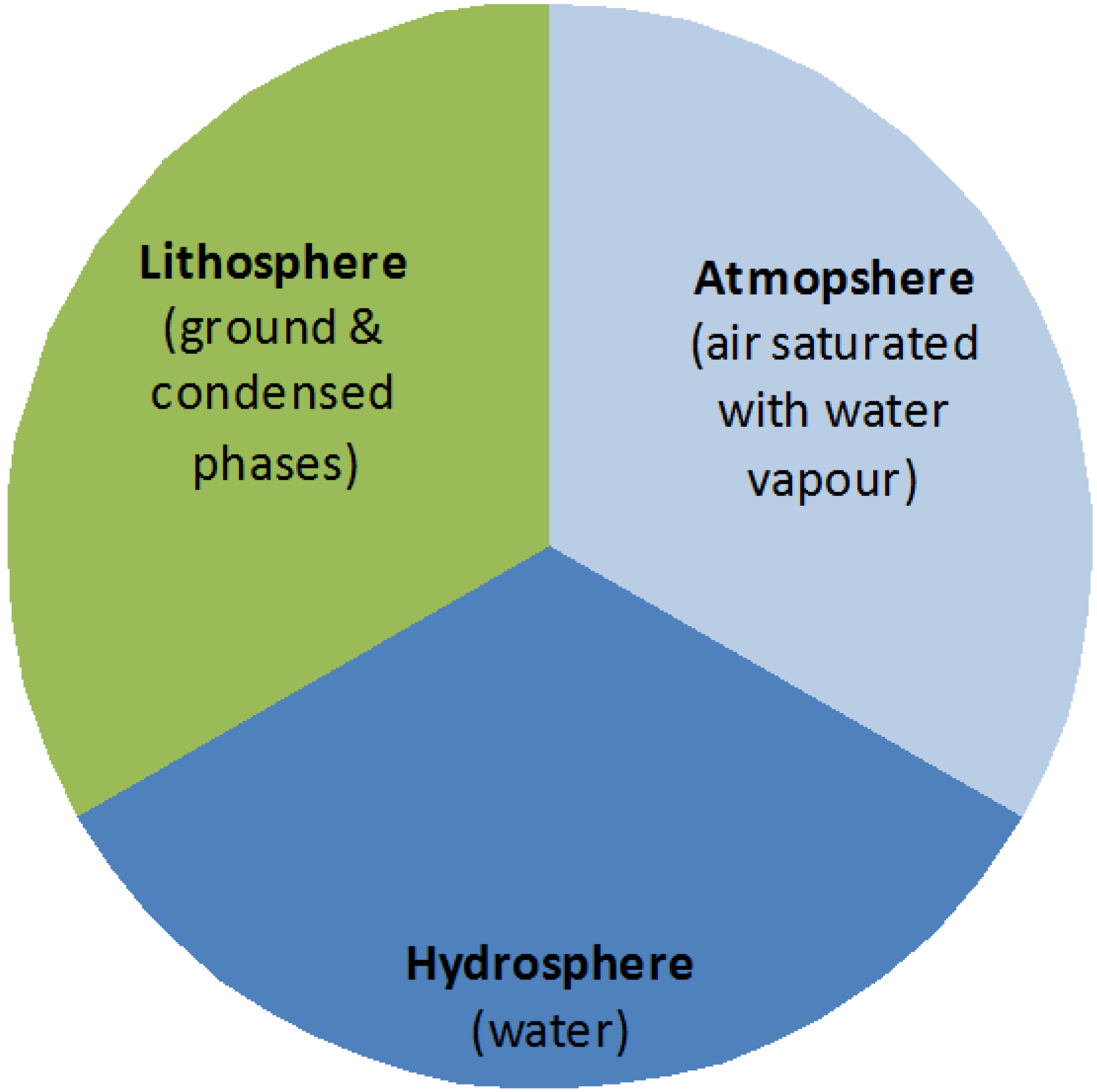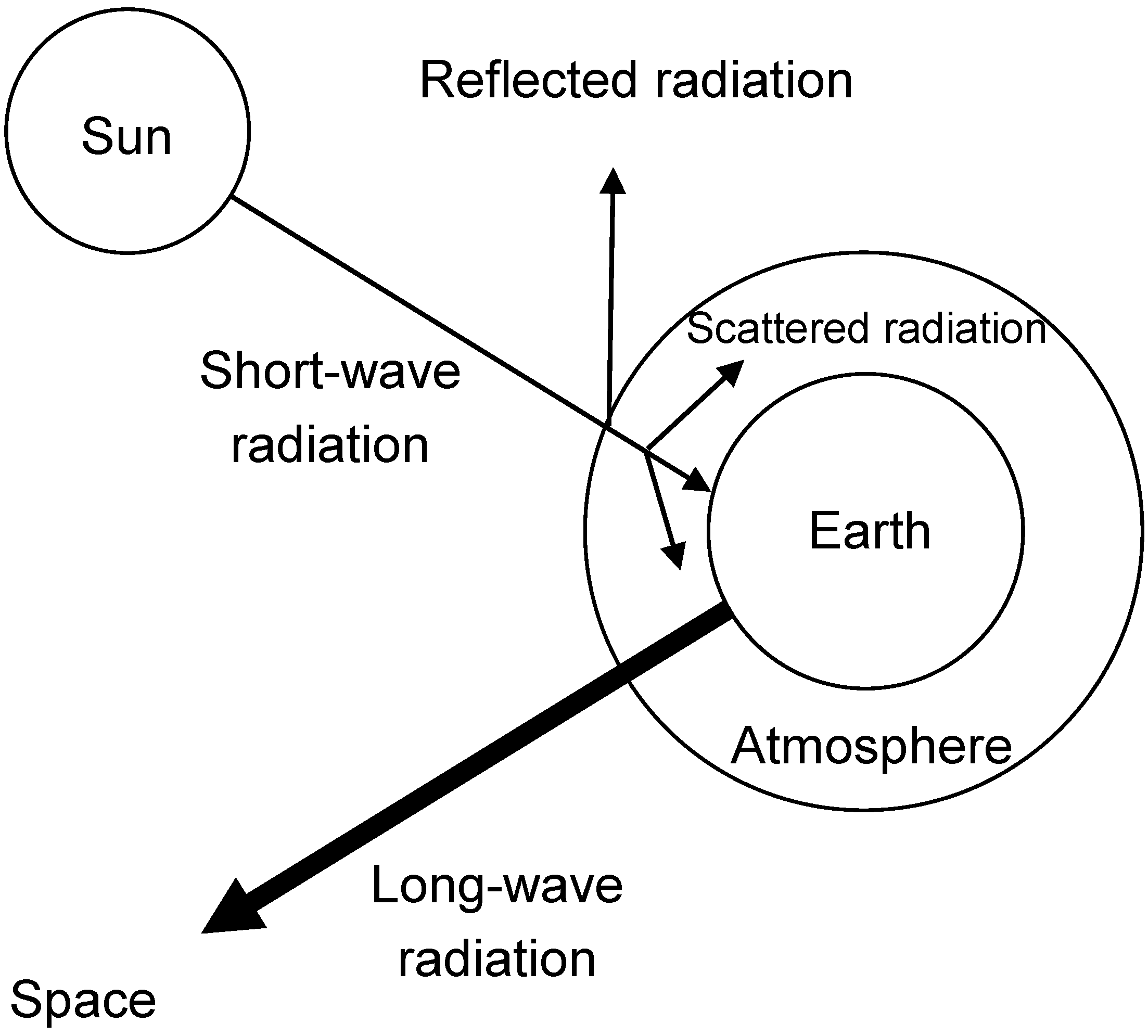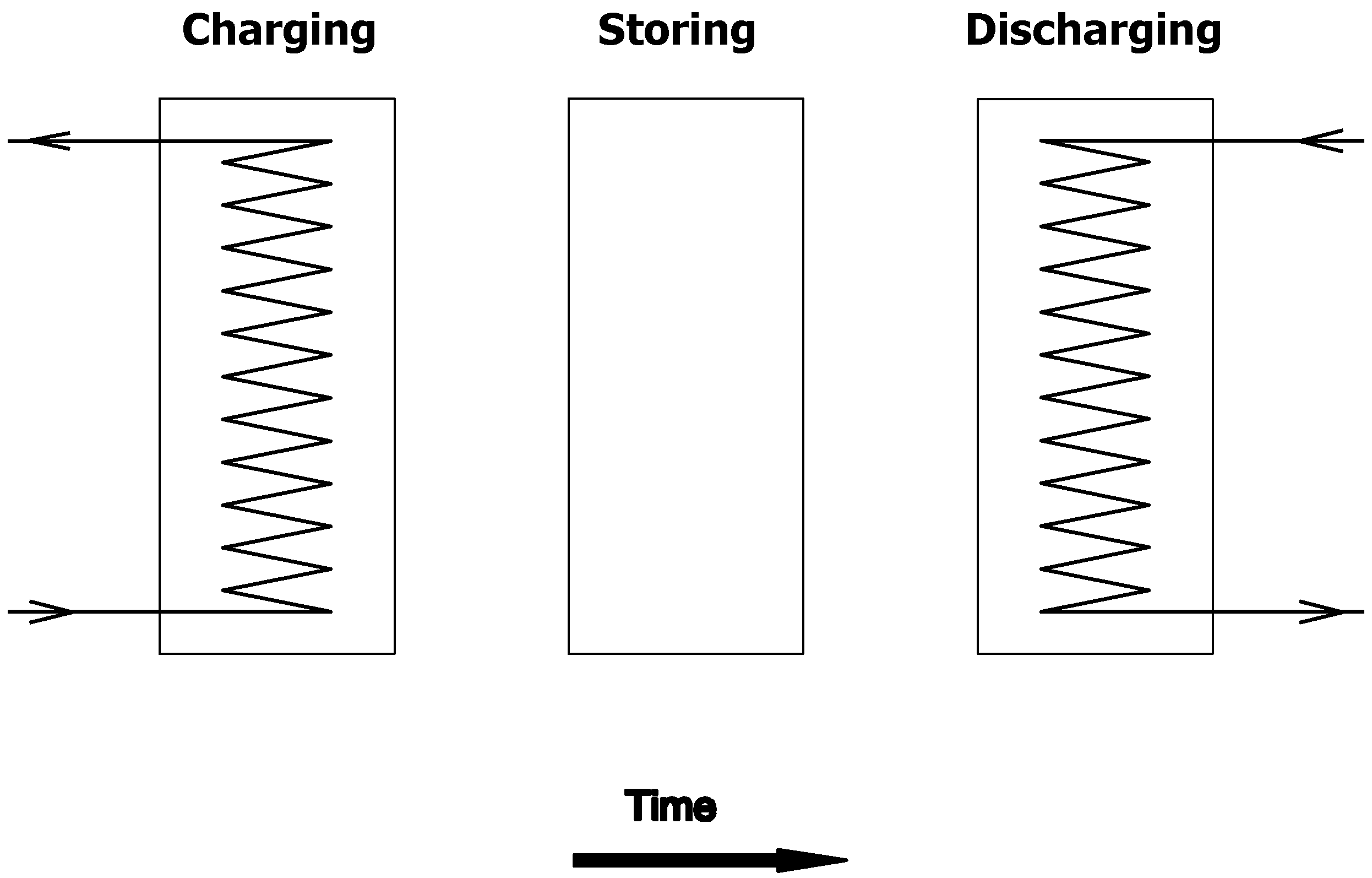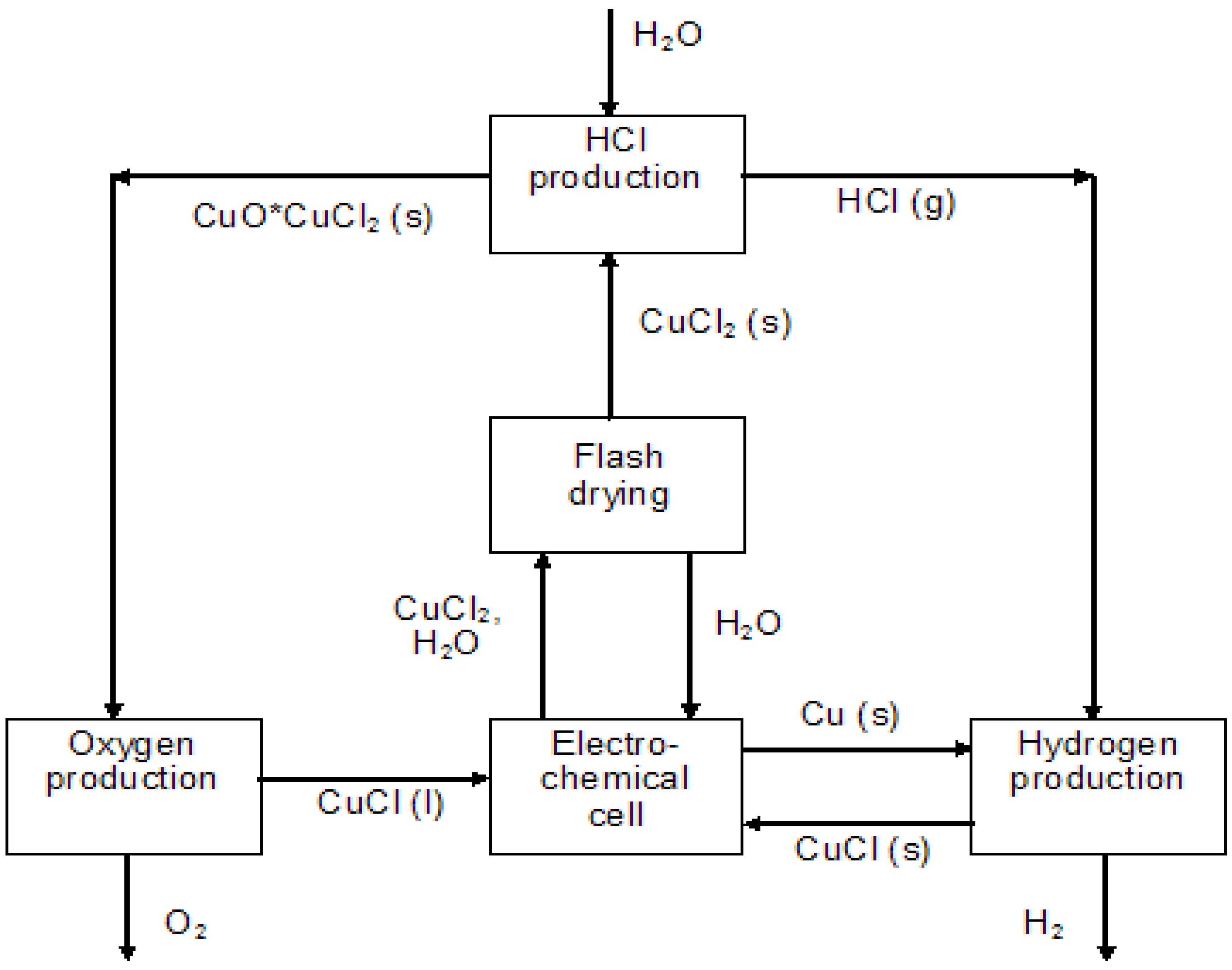Energy Sustainability: A Pragmatic Approach and Illustrations
Abstract
:1. Introduction
2. Background
2.1. Energy
- Energy forms: Energy comes in a variety of forms, including fossil fuels, fossil fuel-based products (e.g., gasoline, diesel fuel), uranium, electricity, work (such as the mechanical energy in a rotating engine shaft), heat, heated substances (e.g., steam, hot air), light and other electromagnetic radiation.
- Energy sources: Energy resources (sometimes called primary energy forms) are found in the natural environment. Some are available in finite quantities (e.g., fossil fuels, fossil fuel-containing substances, peat and uranium). Some energy resources are renewable (or relatively renewable), including solar energy, falling water, wind, tides, geothermal heat and biomass fuels (when the growth rate is not below the rate of use). Energy resources are often processed from their raw forms prior to use.
- Energy carriers: Energy carriers (or currencies) are the energy forms that we use, and include some energy resources (e.g., fossil fuels) and processed energy forms (e.g., gasoline, electricity, work and heat). Processed energy forms are not found in the environment.
2.2. Sustainability
2.3. Energy Sustainability
3. Approach to Energy Sustainability
3.1. Harness Sustainable Energy Sources
| Fossil fuels |
| Coal |
| Oil |
| Natural gas |
| Tar sands |
| Oil shales |
| Peat |
| Non-fossil fuels |
| Biomass (when not replenished) |
| Uranium |
| Fusion material (e.g., deuterium) |
| Wastes |
| Solar radiation (direct) |
| Solar-related energy |
| Hydraulic energy |
| Wave energy |
| Wind energy |
| Ocean thermal energy |
| Biomass (when replenished) |
| Non-solar-related energy |
| Geothermal energy (ambient) |
| Geothermal energy (hot) |
| Tidal energy |
3.2. Utilize Sustainable Energy Carriers
| Fossil fuels |
| Upgraded fossil fuels |
| Oil products (e.g., gasoline, diesel fuel, naphtha) |
| Synthetic gaseous fuels (e.g., coal gasification products) |
| Coal products (e.g., coke) |
| Other chemical fuels |
| Hydrogen |
| Methanol |
| Ammonia |
| Work |
| Electrical energy |
| Thermal energy |
| Heat (or a heated medium) |
| Cold (or a cooled medium) |
3.3. Increase Efficiency
3.4. Reduce Environmental Impact
- acidification (the impact on soil and water of acidic emissions),
- ozone depletion (i.e., destruction of the atmospheric ozone layer and subsequent increases in ultraviolet reaching the earth's surface),
- abiotic resource depletion (due to the extraction of non-renewable raw materials),
- radiological effects (e.g., radiogenic cancer mortality or morbidity due to internal or external radiation exposure),
- ecotoxicity (health problems from exposure to toxic substances), and
- global warming (attributable mainly to greenhouse gas emissions and considered to be a key driver of climate change).



3.5. Improve Socioeconomic Acceptability
- Community involvement and social acceptability. People and communities must be involved in energy-related decisions if energy sustainability is to be attained, as the support of these groups is critical to success of any initiatives, and such support almost always requires consultation and involvement in decision making. A culture of sustainability can evolve when a consultative and collaborative approach is consistently followed.
- Economic affordability and equity. To be sustainable, energy services required to provide basic needs must be economically affordable by all societies and people. It is noted that some energy initiatives affordable at present, e.g., some efficiency improvement and environmental mitigation measures can be implemented in ways that save money over time. All societies need to be able to access energy resources, regardless of geographic location, to achieve energy sustainability. These ideas imply a need for equity among developed and developing countries in terms of energy opportunities. Sustainable energy options need to account for population growth since it places stresses on the environment and the carrying capacity of the planet. Also, energy sustainability requires that future generations be able to access energy resources. Equity in terms of energy is somewhat time dependent, and this author expects that short-term differences will diminish in time and energy opportunities in different countries will converge in the longer term.
- Lifestyles. Modifying lifestyles and tempering desires that are energy-driven can contribute to energy sustainability. Given that aspirations of people tend to increase continually, addressing this factor is often challenging. Transforming behavioural and decision-making patterns requires recognition that current development paths are not sustainable, but such recognition usually occurs only when significant short-term consequences are exhibited, e.g., oil-price shocks, disasters, droughts. To obtain the investments needed to reduce the risks associated with energy initiatives, the public must perceive the long-term consequences associated with present behaviour. Thus, an immediate and difficult challenge for policy makers is translating future threats associated with energy use into near-term priorities.
- Land use and aesthetics. The use of land for energy-related activities must be balanced with other needs, such as agriculture and recreation. This trade off is a particularly significant challenge with technologies like hydraulic energy, which often involves flooding large tracts of land, electricity transmission, which often traverses sensitive ecosystems, wind turbines, which are highly visible, and bioenergy, which often involves the growth of energy plants on land that could be used for other purposes. The aesthetics of the environment affect the well-being of people, making it an important aspect of sustainability. Avoiding damage to environmental aesthetics can be challenging, e.g., renewable energy technologies like solar collectors and wind turbines are considered by many to be detrimental to landscapes.
4. Illustrations
4.1. Thermal Energy Storage

- reduced energy consumption and conservation of fossil fuels (by facilitating more efficient energy use and/or fuel substitution),
- reduced pollutant emissions (CO2, SO2, NOx, CFCs, etc.),
- reduced costs (energy, initial and maintenance), and
- more efficient utilization of equipment and energy.
4.1.1. Underground thermal energy storage

4.1.2. Integrating thermal energy storage with solar energy
4.1.3. Seasonal thermal energy storage
4.2. Heat Pumps
| Process | Energy use (%) | ||
| Electrical | Fuel | All energy forms | |
| Space heating | 15.0 | 79.5 | 66.0 |
| Water heating | 14.0 | 15.0 | 10.0 |
| Cooking | 5.0 | 4.5 | 1.7 |
| Clothes drying | 5.0 | 1.0 | 1.3 |
| Others* | 61.0 | 0.0 | 21.0 |
| Total | 100.0 | 100.0 | 100.0 |
4.2.1. Ground-source heat pumps
4.2.2. Integrating thermal energy storage with ground-source heat pumps
4.3. Cogeneration and Trigeneration
| Regional parameters | Electrical-utility sector parameters | ||||
| Cogeneration penetration | Electricity consumption | CO2 emissions | Coal use | Uranium use | CO2 emissions |
| Low | 5 | 4 | 20 | 7 | 20 |
| High | 30 | 15 | 40 | 35 | 40 |
4.4. Thermochemical Hydrogen Production

| Flow | Energy (% of input energy) | Exergy (% of input exergy) |
| Inputs (high-temp. heat, water) | 100.0 | 100.0 |
| Products (hydrogen; potential by-product oxygen is neglected) | 20.5 | 25.0 |
| Losses | 79.5 | 74.5 |
| External (waste emissions) | 79.5 | 4.5 |
| Internal (consumptions) | - | 70.0 |
| Total products and losses | 100.0 | 100.0 |
4.5. Potential Contributions to Energy Sustainability of the Illustrative Examples
- Sustainable energy sources. Some of the examples considered help improve the utilization of sustainable energy sources and enhance energy-resource flexibility. Ground-source heat pumps produce useful heat partly by exploiting the energy in the ground, which is often referred to as a type of renewable energy. The thermochemical hydrogen production process considered here is designed to utilize non-fossil and sustainable energy resources (nuclear and solar energy). Thermal energy storage facilitates the use of sustainable energy systems but providing a buffer between times of energy availability and need, which is important for the success of intermittent renewable energy resources.
- Sustainable energy carriers. All of the examples produce or involve the use of sustainable and beneficial energy carriers. For instance, heat pumps produce useful heat, while cogeneration produces useful heat and electricity. Trigeneration produces heat, cold and electricity, while thermal energy storage assists the use of heat and cold. Thermochemical water decomposition produces hydrogen energy, a useful chemical fuel that complements electricity. Using the appropriate energy carrier for the corresponding energy demand helps enhance energy sustainability.
- Efficiency. Some of the illustrations involve technologies that greatly improve the efficiency with which energy resources are used and energy services are provided. Heat pumps and cogeneration are particularly noteworthy in this regard. Heat pumps allow heating to be provided with 15% to 25% of the energy that would otherwise be required to provide an equivalent amount of heat. Cogeneration allows electricity and thermal energy to be produced with 10% to 40% less energy resources than would be required to produce the same electricity and thermal energy in separate processes. Efforts to improve the efficiency and to integrate the examples more efficiently into society’s energy systems can also be aided by exergy analysis, which has been applied for some of the illustrations considered. The effectiveness of efficiency measures, in light of such factors as energy rebound, needs to be verified through practical demonstrations and other means.
- Environmental impact. The examples all lead to improved environmental performance in different ways, often for the reasons described in the previous three points. They address two key aspects of reducing environmental impact related to energy (appropriate resources/carriers and efficiency), and thereby enhance energy sustainability.
- Socioeconomic acceptability. Many socioeconomic factors are affected beneficially by the illustrations. For instance, many of the illustrative technologies considered are economically advantageous presently (e.g., heat pumps and cogeneration), improving affordability and equity and therefore enhancing energy sustainability.
5. Conclusions
Acknowledgements
References and Notes
- Rosen, M.A. Towards Energy Sustainability: A Quest of Global Proportions. In Forum on Public Policy Online: A Journal of the Oxford Round Table2009, Summer 2008 edition; pp. 1–20. [Google Scholar]
- Lior, N. Energy resources and use: The present situation and possible paths to the future. Energy 2008, 33, 842–857. [Google Scholar] [CrossRef]
- Ontario Power Authority. Ontario’s Integrated Power System Plan: Scope and Overview. Report. 29 June 2006. [Google Scholar]
- Rosen, M.A. Natural energy. In Encyclopedia of Energy Engineering and Technology; Capehart, B.L., Ed.; Taylor & Francis: New York, USA, 2007; pp. 1088–1095. [Google Scholar]
- World Commission on Environment and Development. Our Common Future; Oxford University Press: Oxford, UK, 1987. [Google Scholar]
- Haberl, H. The global socioeconomic energetic metabolism as a sustainability problem. Energy 2006, 31, 87–99. [Google Scholar] [CrossRef]
- Rosen, M.A. Energy efficiency and sustainable development. Int. J. Global Energy Issues 2002, 17, 23–34. [Google Scholar]
- Goldemberg, J.; Johansson, T.B.; Reddy, A.K.N.; Williams, R.H. Energy for a Sustainable World; Wiley: New York, USA, 1988. [Google Scholar]
- Niele, F. Energy: Engine of Evolution; Elsevier: Oxford, UK, 2005. [Google Scholar]
- Wall, G.; Gong, M. On exergy and sustainable development. Exergy, An International Journal 2001, 1, 128-145, 217-233. [Google Scholar] [CrossRef]
- Zvolinschi, A.; Kjelstrup, S.; Bolland, O.; van der Kooi, H. J. Exergy sustainability indicators as a tool in industrial ecology. Journal of Industrial Ecology 2007, 11, 85–98. [Google Scholar] [CrossRef]
- Hennicke, P.; Fischedick, M. Towards sustainable energy systems: The related role of hydrogen. Energy Policy 2006, 34, 1260–1270. [Google Scholar] [CrossRef]
- Dunn, S. Hydrogen futures: toward a sustainable energy system. Int. J. Hydrogen Energy 2002, 27, 235–264. [Google Scholar] [CrossRef]
- World Energy Assessment Overview: 2004 Update; Johansson, T.B.; Goldemberg, J. (Eds.) United Nations Development Programme: New York, USA, 2004.
- Ayres, R.U.; Turton, H.; Casten, T. Energy efficiency, sustainability and economic growth. Energy 2007, 32, 634–648. [Google Scholar] [CrossRef]
- Cleveland, J. Advanced plants to meet rising expectations for nuclear power. Int. J. Global Energy Issues 2008, 30, 393–412. [Google Scholar] [CrossRef]
- Toth, F.L. Prospects for nuclear power in the 21st century: a world tour. Int. J. Global Energy Issues 2008, 30, 1-4, 3-27. [Google Scholar] [CrossRef]
- Rogner, H.-H.; McDonald, A.; Riahi, K. Long-term performance targets for nuclear energy. Part 1: The global scenario context. Int. J. Global Energy Issues 2008, 30, 1-4, 28-76. [Google Scholar]
- Rogner, H.-H.; McDonald, A.; Riahi, K. Long-term performance targets for nuclear energy. Part 2: Markets and learning rates. Int. J. Global Energy Issues 2008, 30, 1-4, 77-101. [Google Scholar]
- Scott, D.S. Smelling Land: The Hydrogen Defense Against Climate Catastrophe; Canadian Hydrogen Association: Ottawa, Canada, 2007. [Google Scholar]
- Marban, G.; Valdes-Solis, T. Towards the hydrogen economy? International Journal of Hydrogen Energy 2007, 32, 1625–1637. [Google Scholar] [CrossRef]
- Penner, S.S. Steps toward the hydrogen economy. Energy 2006, 31, 33–43. [Google Scholar] [CrossRef]
- Dalcor Consultants Ltd.; Intuit Strategy Inc. Canadian Hydrogen: Current Status and Future Prospects; Natural Resources: Canada, Ottawa, 2004. [Google Scholar]
- Lattin, W.C.; Utgikar, V.P. Transition to hydrogen economy in the United States: A 2006 status report. Int. J. Hydrogen Energy 2007, 32, 3230–3237. [Google Scholar] [CrossRef]
- Arnason, B.; Sigfusson, T.I. Iceland—A future hydrogen economy. Int. J. Hydrogen Energy 2000, 25, 389–394. [Google Scholar] [CrossRef]
- Yildiz, B.; Kazimi, M.S. Efficiency of hydrogen production systems using alternative energy technologies. Int. J. Hydrogen Energy 2006, 31, 77–92. [Google Scholar] [CrossRef]
- Sigfusson, T.I. Pathways to hydrogen as an energy carrier. Phil. Trans. R. Soc. A 2007, 365, 1853, 1025-1042. [Google Scholar] [CrossRef]
- Marchetti, C. Long-term global vision of nuclear-produced hydrogen. Int. J. Nuclear Hydrogen Production and Applications 2006, 1, 13–19. [Google Scholar] [CrossRef]
- Soutworth, F.; Gauthier, J.-C.; Lecomte, M.; Carre, F. Potential applications for nuclear energy besides electricity generation: AREVA global perspective of HTR potential market. In Proc. Conf. on Advanced Nuclear Fuel Cycles and Systems, Boise, Idaho, 9-13 Sept. 2007; pp. 1563–1574.
- Madlener, R.; Alcott, B. Energy rebound and economic growth: A review of the main issues and research needs. Energy 2009, 34, 370–376. [Google Scholar] [CrossRef]
- Dimitropoulos, J. Energy productivity improvements and the rebound effect: An overview of the state of knowledge. Energy Policy 2007, 35, 6354–6363. [Google Scholar] [CrossRef]
- Hanley, N.; McGregor, P.G.; Swales, J.K.; Turner, K. Do increases in energy efficiency improve environmental quality and sustainability? Ecological Economics 2009, 68, 692–709. [Google Scholar] [CrossRef]
- Dincer, I.; Rosen, M.A. Exergy: Energy, Environment and Sustainable Development; Elsevier: Oxford, UK, 2007. [Google Scholar]
- Szargut, J. Exergy Method: Technical and Ecological Applications; WIT Press: Southampton, UK, 2005. [Google Scholar]
- Rosen, M.A.; Dincer, I.; Kanoglu, M. Role of exergy in increasing efficiency and sustainability and reducing environmental impact. Energy Policy 2008, 36, 128–137. [Google Scholar] [CrossRef]
- Rosen, M.A.; Dincer, I. Exergoeconomic analysis of power plants operating on various fuels. Applied Thermal Engineering 2003, 23, 643–658. [Google Scholar] [CrossRef]
- Sciubba, E. From engineering economics to extended exergy accounting: a possible path from monetary to resource-based costing. Journal of Industrial Ecology 2004, 8, 4, 19-40. [Google Scholar] [CrossRef]
- Jorgensen, S.E.; Svirezhev, Y.M. Towards a Thermodynamic Theory for Ecological Systems; Elsevier: Oxford, UK, 2004. [Google Scholar]
- Dincer, I.; Rosen, M.A. Thermal Energy Storage Systems and Applications; Wiley: London, 2002. [Google Scholar]
- Dincer, I.; Rosen, M.A. Use of thermal energy storage for sustainable buildings. Proceedings of the Institution of Civil Engineers—Energy 2007, 160, 113–121. [Google Scholar] [CrossRef]
- Rosen, M.A.; Le, M.N.; Dincer, I. Efficiency analysis of a cogeneration and district energy system. Applied Thermal Engineering 2005, 25, 147–159. [Google Scholar] [CrossRef]
- Barclay, F.J. Fuel Cells, Engines and Hydrogen: An Exergy Approach; Wiley: New York, USA, 2006. [Google Scholar]
- Rosen, M.A. Thermodynamic analysis of hydrogen production by thermochemical water decomposition using the Ispra Mark-10 cycle. In Hydrogen Energy Progress 8; Veziroglu, T.N., Takahashi, P.K., Eds.; Pergamon: Toronto, Canada, 1990; pp. 701–710. [Google Scholar]
- Abanades, S.; Charvin, P.G.; Flamant Neveu, P. Screening of water-splitting thermochemical cycles potentially attractive for hydrogen production by concentrated solar energy. Energy 2006, 31, 2805–2822. [Google Scholar] [CrossRef]
- Orhan, M.F.; Dincer, I.; Rosen, M.A. Energy and exergy assessments of the hydrogen production step of a copper-chlorine thermochemical water splitting cycle driven by nuclear-based heat. Int. J. Hydrogen Energy 2008, 33, 6456–6466. [Google Scholar] [CrossRef]
- Graedel, T.E.; Allenby, B.R. Industrial Ecology, 2nd Ed. ed; Prentice Hall: Upper Saddle River, NJ, USA, 2003. [Google Scholar]
- Granovskii, M.; Dincer, I.; Rosen, M.A. Exergetic life cycle assessment of hydrogen production from renewables. Journal of Power Sources 2007, 167, 461–471. [Google Scholar] [CrossRef]
- Utgikar, V.; Thiesen, T. Life cycle assessment of high temperature electrolysis for hydrogen production via nuclear energy. Int. J. Hydrogen Energy 2006, 31, 939–944. [Google Scholar] [CrossRef]
- Solli, C.; Stromman, A.H.; Hertwich, E.G. Fission or Fossil: Life Cycle Assessment of Hydrogen Production. Proceedings of the IEEE 2006, 94/10, 1785–1794. [Google Scholar] [CrossRef]
- Rohracher, H. Energy systems in transition: Contributions from social sciences. International Journal of Environmental Technology and Management 2008, 9, 144–161. [Google Scholar] [CrossRef]
- Verbong, G.; Geels, F. The ongoing energy transition: Lessons from a socio-technical, multi-level analysis of the Dutch electricity system (1960–2004). Energy Policy 2007, 35, 1025–1037. [Google Scholar] [CrossRef]
- Kemp, R.; Rotmans, J.; Loorbach, D. Assessing the Dutch energy transition policy: How does it deal with dilemmas of managing transitions? Journal of Environmental Policy & Planning 2007, 9, 315–331. [Google Scholar] [CrossRef]
- Thermal Energy Storage for Sustainable Energy Consumption: Proceedings of the NATO Advanced Study Institute on Thermal Energy Storage for Sustainable Energy Consumption – Fundamentals, Case Studies and Design; Paksoy, H.O. (Ed.) NATO Science Series II: Mathematics, Physics and Chemistry; Springer: New York, USA, 2007.
- Beggs, C.B. Ice thermal storage: impact on United Kingdom carbon dioxide emissions. Building Services Engineering Research and Technology 1994, 15, 1, 756-763. [Google Scholar] [CrossRef]
- Reindl, D.T. Characterizing the Marginal Basis Source Energy Emissions Associated with Comfort Cooling Systems. 1994. [Google Scholar]
- California Energy Commission. Source Energy and Environmental Impacts of Thermal Energy Storage; Report P500-95-005; California, 1996. [Google Scholar]
- Rosen, M.A.; Tang, R.; Dincer, I. Effect of stratification on energy and exergy capacities in thermal storage systems. Int. J. Energy Research 2004, 28, 177–193. [Google Scholar] [CrossRef]
- Canhoto, P.; Reis, A.H.; Miguel, A.F.; Rosa, R. Utilisation of air-groundwater exergy potential for improvement of the performance of heat pump systems. Int. J. Exergy 2006, 3, 1–15. [Google Scholar] [CrossRef]
- Rosen, M.A.; Hamzeh, H. Empirical comparison of temperature-distribution models for energy and exergy analyses of stratified thermal energy storages. Int. J. Green Energy 2006, 3, 291–307. [Google Scholar] [CrossRef]
- Hanova, J.; Dowlatabadi, H. Strategic GHG reduction through the use of ground source heat pump technology. Environmental Research Letters 2007, 2, 4, paper 044001. [Google Scholar]
- Spitler, J.D. Ground-source heat pump system research – past, present, and future. International Journal of HVAC&R 2005, 11, 165–167. [Google Scholar] [CrossRef]
- Statistics Canada. Energy supply and demand: 2006. The Daily 2007. [Google Scholar]
- Statistics Canada. Primary and secondary energy – Ontario. Tables 1-8 and 2-8 in Report on Energy Supply-Demand in Canada – 2006. Report 57-003-X. 3 June 2008. [Google Scholar]
- Halozan, H. Ground-source heat pumps and buildings. In Proc. 9th International IEA Heat Pump Conference, Zurich, 20-22 May 2008.
- Canadian GeoExchange Coalition. Survey of Canadian geoexchange industry: 2004-2006. 2007, 10–13. [Google Scholar]
- Emho, L. District energy efficiency improvement with trigeneration: basic considerations and case studies. Energy Engineering: Journal of the Association of Energy Engineering 2003, 100, 2, 66-80. [Google Scholar]
- Teopa Calva, E.; Picón Núñez, M.; Rodríguez Toral, M.A. Thermal integration of trigeneration systems. Applied Thermal Engineering 2005, 25, 973–984. [Google Scholar] [CrossRef]
- Ghosh, S.; De, S. Energy analysis of a cogeneration plant using coal gasification and solid oxide fuel cell. Energy 2006, 31, 345–363. [Google Scholar] [CrossRef]
- Yokoyama, R.; Ito, K. Optimal design of gas turbine cogeneration plants in consideration of discreteness of equipment capabilities. J. Eng. Gas Turbines Power 2006, 128, 336–343. [Google Scholar] [CrossRef]
- Rosen, M.A. Energy, environmental, health and cost benefits of cogeneration from fossil fuels and nuclear energy using the electrical utility facilities of a province. Energy for Sustainable Development 2009, 13, 42–50. [Google Scholar] [CrossRef]
- Kanoglu, M.; Dincer, I.; Rosen, M.A. Exergetic performance analysis of various cogeneration systems for buildings. ASHRAE Transactions 2007, 113(Part 2), 105–112. [Google Scholar]
- Misa, T.; Crisford, M.; Jain, S.; Bansal, P.K. Thermodynamic analysis of an in-situ cogeneration plant. Proceedings of the Institution of Mechanical Engineers, Part A: Journal of Power and Energy 2007, 221, 591–602. [Google Scholar] [CrossRef]
- Gusdorf, J.; Douglas, M.A.; Szadkowski, F.; Yang, L.; Limouse, E.; Manning, M.; Swinton, M. Residential total energy system installation at the Canadian Centre for Housing Technology. Cogeneration and Distributed Generation Journal 2008, 23, 1, 33-51. [Google Scholar] [CrossRef]
- Bertaa, G.L.; Pratob, A.P.; Garbarino, L. Design criteria for distributed cogeneration plants. Energy 2006, 31, 1403–1416. [Google Scholar] [CrossRef]
- Funk, J.E. Thermochemical hydrogen production: past and present. Int. J. Hydrogen Energy 2001, 26, 185–190. [Google Scholar] [CrossRef]
- Organisation for Economic Co-operation and Development. In Nuclear Production of Hydrogen: Proc. Third Information Exchange Meeting; OECD Publishing: Oarai, Japan, 2006.
- Schultz, K.; Herring, S.; Lewis, M.; Summers, W. The hydrogen reaction. Nuclear Engineering International 2005, 50, 10–19. [Google Scholar]
- Le Duigou, A.; Borgard, J.M.; Larousse, B.; Doizi, D.; Allen, R.; Ewan, B.C.; Priestman, G.H.; Elder, R.; Devonshire, R.; Ramos, V.; Cerri, G.; Salvini, C.; Giovannelli, A.; De Maria, G.; Corgnale, C.; Brutti, S.; Roeb, M.; Noglik, A.; Rietbrock, P.-M.; Mohr, S.; de Oliveira, L.; Monnerie, N.; Schmitz, M.; Sattler, C.; Orden Martinez, A.; de Lorenzo Manzano, D.; Cedillo Rojas, J.; Dechelotte, S.; Baudouin, O. HYTHEC: An EC funded search for a long term massive hydrogen production route using solar and nuclear technologies. Int. J. Hydrogen Energy 2007, 32, 1516–1529. [Google Scholar] [CrossRef]
- Forsberg, C.W. Hydrogen, nuclear energy and advanced high-temperature reactor. Int. J. Hydrogen Energy 2003, 28, 1073–1081. [Google Scholar]
- Suppiah, S.; Li, J.; Sadhankar, R.; Kutchcoskie, K.J.; Lewis, M. Study of the hybrid Cu-Cl cycle for nuclear hydrogen production. In Nuclear Production of Hydrogen: Proc. Third Information Exchange Meeting; OECD Publishing: Oarai, Japan, 2006; pp. 231–238. [Google Scholar]
- Arif Khan, M.; Chen, Y. Preliminary process analysis and simulation of the Copper-Chlorine thermochemical cycle for hydrogen generation. In Nuclear Production of Hydrogen: Proc. Third Information Exchange Meeting; OECD Publishing: Oarai, Japan, 2006; pp. 239–248. [Google Scholar]
- Lewis, M.A.; Serban, M.; Basco, J.K. Hydrogen production at <550oC using a low temperature thermochemical cycle. In Proc. ANS/ENS Exposition; New Orleans, 2003. [Google Scholar]
- Steinfeld, A. Solar thermochemical production of hydrogen––A review. Solar Energy 2005, 78, 603–615. [Google Scholar] [CrossRef]
- Steinfeld, A. Solar hydrogen production via a two-step water-splitting thermochemical cycle based on Zn/ZnO redox reactions. Int. J. Hydrogen Energy 2002, 27, 611–619. [Google Scholar] [CrossRef]
- Lubis, L.I.; Dincer, I.; Rosen, M.A. Preliminary life cycle assessment of nuclear-based hydrogen production using thermochemical water decomposition. In Proc. 3rd IASME/WSEAS Int. Conf. on Energy and Environment, Cambridge, UK, 23-25 Feb. 2008; pp. 487–494.
- Utgikar, V.; Ward, B. Life cycle assessment of ISPRA Mark 9 thermochemical cycle for nuclear hydrogen production. J. Chemical Technology 2006, 81, 1753–1759. [Google Scholar]
© 2009 by the authors; licensee Molecular Diversity Preservation International, Basel, Switzerland. This article is an open-access article distributed under the terms and conditions of the Creative Commons Attribution license (http://creativecommons.org/licenses/by/3.0/).
Share and Cite
Rosen, M.A. Energy Sustainability: A Pragmatic Approach and Illustrations. Sustainability 2009, 1, 55-80. https://doi.org/10.3390/su1010055
Rosen MA. Energy Sustainability: A Pragmatic Approach and Illustrations. Sustainability. 2009; 1(1):55-80. https://doi.org/10.3390/su1010055
Chicago/Turabian StyleRosen, Marc A. 2009. "Energy Sustainability: A Pragmatic Approach and Illustrations" Sustainability 1, no. 1: 55-80. https://doi.org/10.3390/su1010055
APA StyleRosen, M. A. (2009). Energy Sustainability: A Pragmatic Approach and Illustrations. Sustainability, 1(1), 55-80. https://doi.org/10.3390/su1010055





